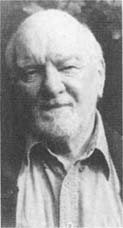CHAPTER FIVE
The Pals Industry
Introduction
In July 1996 a Guardian journalist wrote an article headed, ‘Friends of the dear old Pals’ in which he coined the phrase ‘Pals Industry’. This described the work done – and which continues to be done – by the Tourist Information Centre, the Local Studies Library and St. John’s Church in Accrington to further the memory of the Pals.
In addition, Benjamin Hargreaves Primary School in Accrington has its own ‘Pals Project’ as part of its curriculum (also now done by other schools in the area). Finally, Mr. Peter Whelan, the noted playwright, inspired by Martin Middlebrook’s The First Day on the Somme, wrote the extremely popular play, The Accrington Pals.
The following contributions are each a personal view of their part in the ‘Pals Industry’:
1. Helene Heyes – The Tourist Information Centre
2. Helen Barrett – The Local Studies Library
3. Revd. Dennis Crook – The Pals Chapel, St. John’s.
4. Enid Briggs -A School’s Pals Project
5. Peter Whelan – The play. The Accrington Pals
1. Helene Heyes – The Tourist Information Centre
Accrington has had a networked Tourist Information Centre since 1990, although Hyndburn Borough Council have provided an Information Centre dealing with local tourism since the mid 1980s. In April 1997 the Lancashire County Council Information Centre, merged with the Tourist Information Centre and this then became the Accrington Information Centre.
Visitors and residents usually know three things associated with this area: Accrington Stanley Football Club; Accrington ‘Nori ‘Brick and the Accrington Pals.
An ever increasing number of the queries we deal with are from people who are interested in the Pals and want to obtain further information.
With this in mind, it was decided that the Council should produce its own Accrington Pals Leaflet in association with Accrington Library. The leaflet contains a brief history of the Pals, information regarding The Pals Memorial Chapel at St.John the Evangelist Church, an ‘Accrington Pals Town Trail’ and details of museums, events and books associated with the Pals. The leaflet was launched on 1 July, 1992, at the Pals Chapel with the Mayor, Cllr Mrs Cathleen Thorn together with Mr William Marshall, who at 99 was the last surviving Pal. The leaflet has been an outstanding success and has been reprinted on an annual basis.
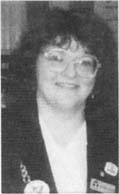
Helene Heyes(The Author)
In 1993, Bill Turner lent the Tourist Information Centre a slide of a patriotic postcard that the Pals sent to their family and friends when they were training at Caernarfon, Wales, during 1915. We asked local photographer, Alfred Hoole to take a photo of the Pals Chapel and the two shots were used to produce the Pals Postcards. Again, these have proved to be very successful.
Accrington Town Hall underwent extensive renovation work during 1993, prior to the relocation of the Tourist Information Centre in November of that year. The new Centre is now on the site of the original Council Chamber where the Pals Battalion was raised in 1914. We thought that we should draw the public’s attention to this, and so a plaque was placed in a prominent position which states:
To Commemorate
The 11th (Service) Battalion (Accrington)
East Lancashire Regiment (The Accrington Pals)
Was formally raised in this room
(The former Council Chamber)
By the Mayor of Accrington, Councillor John Harwood
On the 7th day of September, 1914
Unveiled by William Turner, November 11th 1994
Peter Whelans play The Accrington Pals is performed regularly throughout the country and we often receive requests from theatre groups, both professional and amateur, who wish to visit the area and see for themselves the places that the Pals knew and to visit the Pals Chapel, the War Memorial in Oak Hill Park and of course the Local Studies Department of Accrington Library. The Pals leaflets have been used by many of these groups to enable their audiences to learn more about Pals.
Our next project regarding the Pals came about from a member of the public who called into the Information Centre and noticed that we sold commemorative plates relating to the mining industry which was once so prevalent in this area. He asked whether he could get one about the Accrington Pals?
The Accrington Pals Commemorative Plate was designed by ourselves and was launched on 1 July, 1995. It features the Pals Memorial in Serre, Regimental Colours & Drum. The local towns and villages where the Pals came from are featured on the side of the plate. The reverse has a brief history of the Pals. The plate is a limited edition of 650 and we have received requests from throughout the UK and also from France & USA.
1996 was the 80th anniversary of The Battle of The Somme and our largest and most successful project to date was the “The Accrington Pals Exhibition”, which was held in the Town Hall. Originally the exhibition was scheduled to run during the month of July. However the response from the public was such that we had to extend the run of the exhibition throughout August as well. Over 1000 people a week came to view the exhibition and as the Visitors Book showed, they came from throughout the country. Many overseas visitors who were in this area staying with family and friends also came to the exhibition.
The exhibition was organised in conjunction with Accrington Library. The pupils from Benjamin Hargreaves Junior School brought in their Accrington Pals Project for the exhibition. Each pupil ‘adopted’ a Pal and wrote about them, this included poems, prayers and pictures. Their contribution was very moving and was a highlight of the exhibition. We asked the public for any material they might be willing to loan us for the exhibition and we were amazed by the response. Items were brought in on a daily basis throughout the two months that the exhibition was open. Blackburn Museum kindly loaned us a German Maxim Machine Gun which was captured in 1918 by the Pals, the Regimental Museum also loaned various artefacts. Quite a few items brought in by the public were donated to us and these are now held in our Cellar Exhibition area which is opened to the public as part of our regular guided tours of Accrington Town Hall.
The Information Centre staff are also asked on a regular basis for details regarding accommodation and places to visit in the Somme, especially Serre. Following on from the success of the exhibition, it was decided to send a member of staff to the Somme to learn at first hand more about this region. The trip was led by Bill Turner and apart from visiting the cemeteries and memorials connected with the Pals, we left information relating to the Pals and Accrington at all the major Museums, Hotels and Tourist Information Centres as part of our service to tourists and battlefield historians alike.
The Accrington Pals Exhibition underlined to us the importance of keeping the memory of the Pals alive. To this end the Information Centre stocks not only our own items but various other items which are connected to the Pals and the Battle of The Somme, e.g.
Accrington Pals Book (W. Turner) (Pen & Sword Books Ltd.) Accrington Pals Remembered (A guide to their last resting places & memorials) (W Turner)
The Somme Battlefront Pack (P.R.O.)
Army Service Records (P.R.O.)
Battleground Europe – Serre Book (J. Horsfall) (Pen & Sword Books Ltd.)
Lapel Badge (East Lanes Reg.)
Keyring (East Lanes Reg.)
Accrington Information Centre
Town Hall
Blackburn Road
ACCRINGTON
Lancashire
BB5 ILA
Tel: 01254 386807 I 872595 Fax: 01254 380291 e-mail: – leisure@hyndburnbc.gov.uk
Internet: – http:/www.newsquest.co.uk/llt/hyndburn/
2. Helen Barrett B.A. A.L.A. – World War One Collection of Accrington Library
Accrington Library may seem to some to be a surprising place for a major collection of some 1500 volumes of literature on World War One. The collection dates back to the 1950’s when subject specialisation schemes were adopted in public libraries. This ensured, as far as possible, the complete coverage by an individual library, of a particular subject. Local industry, culture and local history were the criteria for deciding each library’s allocation and so Accrington came to specialise in World War One.
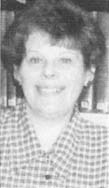
Helen Barrett(The Author)
In 1974 Accrington library became the District Library for the new Hyndburn authority and the decision was made to continue the W.W.I specialisation, but with a slightly different emphasis and with selective purchase. As the publication of books about the war continues the purchase of everything is not possible. Accordingly, a policy evolved of acquiring material which would enable researchers to trace individuals, whilst at the same time major histories would not be ignored.
The Collection is housed in three separate departments. General books about the war, narratives, poetry, biographies etc. are shelved in the Lending Library and the storeroom: the Reference Library has the C.W.G.C. registers, official histories and research material and the Local Studies Library concentrates on material relating to the ‘Accrington Pals’, and to a lesser degree other Lancashire regiments.
The William Turner Pals Collection’ is held on deposit in the Local Studies Library. This is a unique collection of photographs, newspaper cuttings, tape recordings, memorabilia and documentation, complete with a card index. The collection has been used extensively by researchers, television producers, journalists and family historians.
A feature of the Local Studies Library is a 9ft. by 6ft. photograph of 3 and 4 Platoons of ‘A’ Company of the Pals. This was used by the Octagon Theatre, Bolton, in their production of the play ‘The Accrington Pals’ in 1982. Since then the library resources have been used many times by professional and amateur companies staging the play. Library staff maintain a file of posters, newspaper cuttings, theatre programmes and recordings of the play.
The Local Studies Library has a microfilm file of the Accrington Observer and Times from 1887 to date. Rolls of Honour of local men appear regularly from February 1915 and in 1919 the newspaper published a booklet The Greater Accrington Roll of Honour When used in conjunction with The Accrington Pals Remembered by William Turner there is an almost complete list of the local war dead.
A recent addition to stock is an A4 file in three volumes, giving personal details of the 851 Pals (one page per man) who died during the war. A complete list in C.W.G.C. cemetery alphabetical order of all men of the East Lancashire Regiment (including the Pals) buried or commemorated at home or abroad is also available to researchers.
Military books in stock relate specifically to Lancashire unit and regimental histories. There is also a complete set of volumes of the Pals series by Pen and Sword Books. Pupils of a local Primary School have produced Poems about the Accrington Pals. Based on their Pals project, the poems are especially poignant and a credit to the children and their teachers. In 1996 the Public Record Office released to the public a quantity of W.W.I army service records. To mark the occasion a pack of facsimile documents entitled Battlefront was published. The pack includes personal documents relating to a Private James Barnes of the Pals. Also shelved are video tapes relating to the Pals, including a 1915 newsreel.
Also available are the Absent Voter lists of the Electoral Registers. From February 1918 servicemen registered in order to have a vote. The information provided by the serviceman consisted of name, number, regiment corps or ship and service address. This is often of great value to the family historian.
Also of value is Soldiers died in the Great War 1914–1918 on microfilm. Over 667,000 names are listed and each entry includes name, number, place of enlistment, place of residence and the date of death. The precise place of death is not given – only the country. It’s companion publication is Officers died in the Great War, also on microfilm. A 1988 edition in book form contains twelve pages of names previously omitted.
The Reference Library has a complete set of the C.W.G.C. registers of cemeteries and memorials throughout the world. These ensure that a grave or name on a memorial can be traced and some biographical information obtained.
The C.W.G.C. registers were used for the Cross of Sacrifice series, published by S.D. and D.B. Jarvis. The series provides a list of officers who died in the service of the British Commonwealth and colonial countries. There are over 60,000 names with supporting details. Royal Marine deaths are recorded in With Full and Grateful Hearts published in 1991. 6,261 deaths are noted, covering the period August 1914 to October 1919. There are also three ‘Rolls of Honour’ (Hood, Howe and Nelson Battalions) of the Royal Naval Division, published by the Imperial War Museum. These give personal details and number, date of death and theatre of war where death took place. War casualties of the Royal Flying Corps and the Royal Air Force are in Airmen died in the Great War by Chris Hobson. Soldiers Killed on the First Day of the Somme by F W Bell is another useful reference. Other volumes relate the histories of various regiments and divisions.
It can be said that the pride of the Collection is The Official History of the Great War, in 75 volumes. This is a scholarly work, the purpose being ‘to provide within reasonable compass an authoritative account, suitable for general readers and for students at military schools, of the operations of the British Army in 1914 – 1918’.
The Collection also contains many volumes of personal memoirs and accounts of warfare on land, at sea and in the air. A large number of these are rare and unusual volumes dating from the 1920s and 1930s.
The Reference Library also keeps current information on travel to, and accommodation in, the battlefields area and the staff will be happy to deal with enquiries.
The Library staff believe that the W.W.I Collection will enable them to offer a service to researchers equal to, if not better than, most public libraries in the North West.
For anyone wishing to use the World War One Collection the address is:- Accrington Reference Library, St. James’ Street, Accrington, BB5 1NQ, Lancashire. Tel. 01254 872385, Fax. 01254 301066.
3. Revd. Dennis CrookA.K.C. – The Pals Chapel, St. John’s Church
Who would have thought that a pipe organ in need of restoration would have led ultimately to the creation of the Pals Chapel in the church of St. John the Evangelist, Accrington?
The story begins with the discussions surrounding the organ – should it be repaired or perhaps a different scheme considered? Eventually it was agreed that a magnificent organ of 1906 (by T C Lewis) for sale in Glasgow should be purchased. However it was suggested to us that the organ should be placed on a platform in the north transept. The old organ was sold and removed, but two wooden panels were retained to preserve a link with the past. Indeed, many generations of choristers had left their initials upon them. Two such unknown boys had, however, written – ‘Pals in church 21st February 1915’ and ‘Toke (sic) in action at Sir (sic) July 1st 1916. Heavy casualtys’ (sic). These words were to serve as the inspiration for the ‘Pals Chapel.
The Lewis organ was duly re-built and the area underneath was cleared of its pitch pine pews. Demanding and urgent building work placed great claims upon parish resources, but the publication of Bill Turner’s book turned my thoughts to the problem. Bill had discovered that the Pals had used the church for their final service before they left the town – so what could be more appropriate than the siting of a permanent memorial to the Battalion?
It had long been my dream that the church should have a side-chapel; a place of quiet, a still place for smaller Eucharistic services, and the daily saying of morning and evening prayer. I based my ideas on the chapel at Whalley Abbey which had been designed with a central altar with seating on three sides for the congregation. As I read Bills book I realised that there was no one place where the Pals were commemorated. So here was the long awaited opportunity to develop the north transept for the benefit of parishioners and the wider community.
Mr. Christopher Martindale, a distinguished ecclesiastical architect was commissioned to design the chapel. The plans were fully discussed over twelve months and it was agreed that the chapel was to be primarily a place where services and prayer were to be offered on a daily basis. It was not to be a memorial chapel in isolation from the rest of the church but an integral part of it.
The style and design reflect these fundamental principles. The paving of Portuguese stone (English Hoptonwood stone proved to be too expensive) provides a quiet foundation for the richly moulded mahogany stalls. Between the panels and above the pews are seven plaques and banners representing the infantry regiments of Lancashire at the time of the Great War. The eighth (the York and Lancaster Regiment) had a close connection with the Accrington Pals.
The dignified memorial tablet was carved by John Shaw of Accrington and the small cross by Jack Haworth of Hollins School. Other items of interest include the Toc H lamp donated by the Accrington branch. However, particular mention must be made of the drum. It was used as the troops marched between villages in France and was left behind the lines as battle raged. Miraculously, the drum was preserved, along with the drumsticks and was presented to Lt. Col. Rickman in 1919. After his death it remained in the possession of his son, Major Gerry Rickman. He most movingly and generously presented the drum to St. John’s at the dedication of the chapel on 23rd. February 1992.
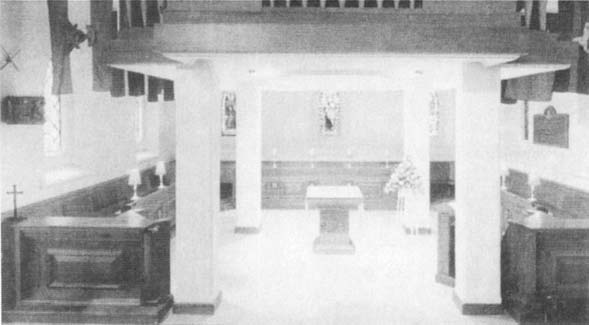
The Pals Chapel. (Hyndburn B.C.)
Since 1992 the chapel has received further beautification and mention must be made of Mr. Alfred Hoole and R. P. Townley, the main contractors. The late Mr. Clifford Collinson was also in the forefront of raising the £30,000 needed for the chapel. Donations have come from public bodies and private individuals – many of whom had a personal link with the Pals.
A great surge of interest came as a result of the church and chapel appearing on the ‘Songs of Praise’ BBC TV programme for Remembrance Sunday 1991. Hundreds of letters were received and visits by groups and individuals arranged, many of whom were pleased to see the names of relatives recorded in the special Book of Remembrance. A steady flow of visitors from home and overseas have been welcomed at the church.
There is an annual service on the Sunday nearest to the 21st of February when the British Legion standard bearers from many branches lead the standards of regimental and other organisations in dignified procession through the church. The silence surrounding the Act of Remembrance which focuses particularly on the Pals is a moving and poignant reminder of our past history. We owe a debt to them which we can never repay.
Yet, as I knelt many times before the altar with faithful congregations I was frequently aware that we did not worship alone. In the chapel, facing the same altar, gather those whose names are recorded in the Book of Remembrance. They cannot be seen, but somehow you know they are there, their eyes are God-ward like yours and that your act of worship is an act fully shared with them.
There can be no greater justification for the planning and building of the chapel. I hope that those who come to kneel before the altar and those who make an act of family pilgrimage will be able to sense that we are sharing our communion with a mighty host, for we indeed meet with ‘angels and archangels and with all the company of Heaven’.
4. Enid Briggs – A School’s Pals Project
My husband’s uncle, Walter Briggs, was an Accrington Pal, and died on 1st July, 1916. His family was badly affected, and my father-in-law would never talk about him: only the publication of Mr. Turner’s books encouraged my husband and I to find out more.
We now feel so strongly that the memory of the Accrington Pals should be preserved that we have put together a project for Top Juniors at Benjamin Hargreaves’ C.E. Primary School, Accrington. To give them a feel for the times, the children learn first about pre-war Accrington, and Walter’s family and home life. We then move on to the outbreak of war, concentrating on how Walter and members of his family felt: the pride and patriotism of his father, the fears of his grandfather, the emotions of his fiancee and older sister, as her fiancee, too, goes off to fight, the confusion of his younger brother – the crowds cheer as the soldiers march away, yet his mother weeps in anguish.
At this point, every pupil takes on the identity of a real Accrington Pal The choice of Pals has to be carefully worked out, to ensure the correct proportion – how many died, how many were injured, how many have no known grave, how many returned home to die, how many survived but died in later engagements, etc.. I choose Pals whose pictures can be found in one of Mr. Turner’s books (with the exception of three Pals connected with St. Paul’s Church, whose pictures can be found in newspapers). Except that I might allow particular friends to be ‘brothers’ the identities are given out at random: as in 1916, these Pals have no control over their fate.
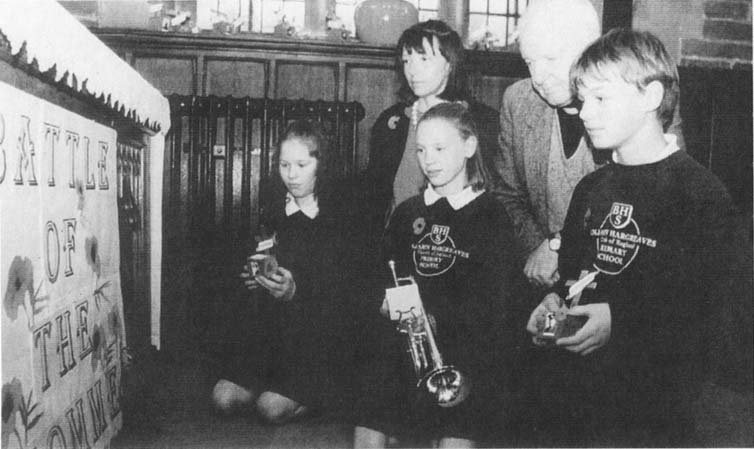
Pupils of Benjamin Hargreaves Primary School, Accrington, look at part of the display designed and made by them as part of their Pals project. Their teacher, Susan Brown and Fred Cook, Rector of Accrington look on.Photograph by kind permission of the Editor. Lancashire Evening Telegraph.
The children learn briefly of the progress of the war, concentrating on the reasons and preparations for the Somme offensive. They learn about life and conditions in the trenches, but all written and art work is undertaken from the point of view of ‘their’ Pal. They write letters, prayers and diaries, constantly examining how these men and their families at home must have felt.
1st July itself takes a full morning, and the mood is sombre. Much use is made of eyewitness accounts and attempts are made to indicate the scale of the casualties.
The next day, the children assemble in the school hall. By this time, many will have discovered ‘their’ fate, but each formally gives his name and is consigned to a group. The atmosphere is tangible as the groups of ‘killed in action’ ‘killed in action, no known grave’, ‘wounded’, grow.
I stress to them that these are the true proportions. Before the exercise, I ask the Class Teacher to choose at random six ‘Pals’ whom she, as an ordinary Accrington woman, might have known – a son, a neighbour, the butcher’s boy, etc.: at the end of the exercise, the outcome is often that she would not have seen any of them again. My husband is a keen photographer, and, as we have visited the Somme region many times, I am able to give each ‘Pal’ who dies a picture of his gravestone or of Thiepval.
We then consider the reactions at home – the delay in receiving news – my own mother’s story of women hearing news from injured soldiers leaning out of a train, and running round to her parents’ shop in distress. We look at newspaper coverage, telegrams and letters, parents’ appeals for news, the horrors and uncertainty behind the word ‘missing’. Throughout, I use precious articles from our own family, and I tell the effect of Walter’s death on each – how his grandfather died soon after, his mother never laughed again, his brother could never speak of him without tears.
We then move to the theme of Remembrance, and the work of the CWGC and the British Legion. The children are encouraged to visit Pals’ graves at Accrington Cemetery, noting the Cross of Sacrifice, and the War Memorial in Oak Hill Park. Earlier in the project, they visit the Chapel at St. John’s Church (seeing, on the way, incidentally, the place where the news-bearing train was standing)
The culmination of the project is a Remembrance Service in St. Paul’s Church on either 1st July or 11th November, incorporating eyewitness accounts, the children’s work and traditional items, and conducted entirely by the children. Poppies are worn by all, and the Church is suitably arrayed. We have been privileged to welcome civic leaders, representatives of the British Legion and local historians, as well as parents and members of the church community: many are in tears.
I believe the children when they say of the Accrington Pals,
‘WE WILL REMEMBER THEM’.
N.B. The most recent project resulted in the publication of a booklet, “Poems about the Accrington Pals”. This is available from the Headteacher, Benjamin Hargreaves Primary School, Barnfield Street, Accrington, price £2.50.
5. Peter Whelan – The play, The Accrington Pals
It’s over fifteen years now since I first had the idea of writing ‘The Accrington Pals ‘for the theatre……and I still recall vividly how it came about.
I’d never visited Accrington until I wrote about it……though when I did I was struck by the kinship with the Potteries where I grew up. Both are close, compact, industrial communities set amongst high moorlands, visible above the rooftops and at the end of streets. Both had (do they still?) an active Primitive Methodist movement I was part of it myself long ago.
My parents came from Salford and for some years before 1980 I’d wanted to write a play about them when they were young in the First World War. My father was in the Manchester Regiment and my mother, for a time, became a forester, sent on active service to chop down trees in Sussex!
The nub of the idea came when I read Martin Middlebrook’s The First Day on the Somme’, a pulverising account of Britain’s awakening to machine age violence.
One short paragraph caught my imagination. It concerned what happened in Accrington after the battle…how townspeople, driven desperate by rumours of disaster and angered by ludicrously optimistic reports in the press, marched to the mayor’s house to demand the truth.
Some have since told me that this never happened, though Martin always stoutly maintained that it did. For me it set the mood for a play about those left behind when the Pals went off to war. It was to be a play about the tensions of resisting authority and the tragedies of upholding it…and a play about the most basic divisions between us all, putting politics on a personal level
Above all it was to be a fractured love story between a strong minded, individualistic woman and a dreamy young socialist who joins the Pals. It was also to be a play about a community of women, recognising that the doors that opened for them in that war gave tantalising glimpses of freedom, as well as scenes of horror.
Writing the play put me in touch with a few of the surviving Pals and two of them were able to come to the opening of the production in London. Since then it has been widely performed in New York, as well as in major British theatres. An adaptation was broadcast on Radio Four and there have been constant amateur productions over the years.
It is the play that very much encouraged me to persevere as a playwright. So, you can imagine, I have a lot of affection for it.
N.B.
Performing rights
Amateur rights are handled by Samuel French Ltd., 26 Southampton Street, Strand,
London WC2E 7JE.
The script of “The Accrington Pals”, by Peter Whelan is published by Samuel French Ltd, is obtainable from the larger bookshops, price £5.50 (1997) ISBN 0 57311 00 93.
Biographical Note
Peter Whelan was born in the Potteries in 1931. After National Service and Keele University he made a career in advertising together with short film scripting before writing full-time for the stage. His first solo play was ‘Captain Swing’, a story of the revolt against agricultural machinery. Then, in 1981 came ‘The Accrington Pals’.
Peter Whelan’s other works, most of which were for the Royal Shakespeare Company, include ‘The School of Night’, a play about Christopher Marlowe; ‘The Herbal Bed’, about Shakespeare’s daughter Susanna; ‘Divine Right’, about republicanism in a future England and ‘Overture’, a play about the ugliness of the modern world.
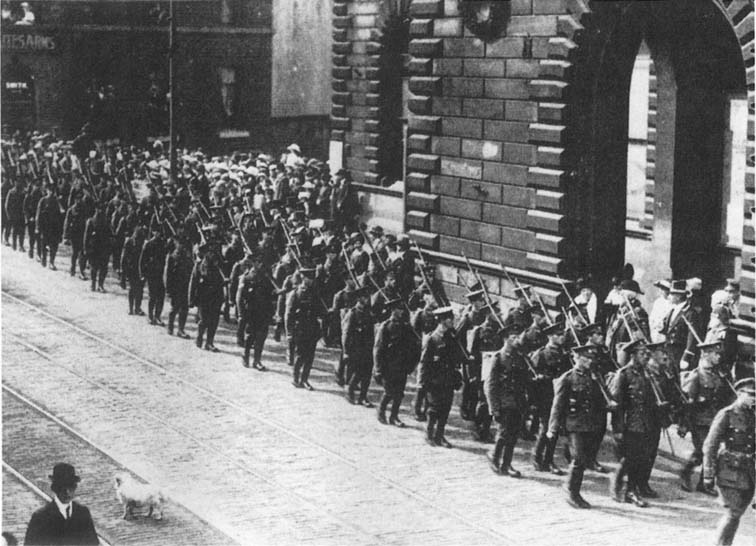
The Mayor, John Harwood, takes the salute as the Battalion march past the Town Hall on 2 August 1915. (The Pals Collection)
